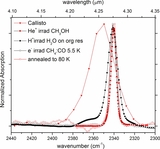Carbonic Acid as a Reserve of Carbon Dioxide on Icy Moons: The Formation of Carbon Dioxide (CO2) in a Polar Environment
Abstract
Carbon dioxide (CO2) has been detected on the surface of several icy moons of Jupiter and Saturn via observation of the ν3 band with the Near-Infrared Mapping Spectrometer on board the Galileo spacecraft and the Visible-Infrared Mapping Spectrometer on board the Cassini spacecraft. Interestingly, the CO2 band for several of these moons exhibits a blueshift along with a broader profile than that seen in laboratory studies and other astrophysical environments. As such, numerous attempts have been made in order to clarify this abnormal behavior; however, it currently lacks an acceptable physical or chemical explanation. We present a rather surprising result pertaining to the synthesis of carbon dioxide in a polar environment. Here, carbonic acid was synthesized in a water (H2O)-carbon dioxide (CO2) (1:5) ice mixture exposed to ionizing radiation in the form of 5 keV electrons. The irradiated ice mixture was then annealed, producing pure carbonic acid which was then subsequently irradiated, recycling water and carbon dioxide. However, the observed carbon dioxide ν3 band matches almost exactly with that observed on Callisto; subsequent temperature program desorption studies reveal that carbon dioxide synthesized under these conditions remains in solid form until 160 K, i.e., the sublimation temperature of water. Consequently, our results suggest that carbon dioxide on Callisto as well as other icy moons is indeed complexed with water rationalizing the shift in peak frequency, broad profile, and the solid state existence on these relatively warm moons.
- Publication:
-
The Astrophysical Journal
- Pub Date:
- June 2014
- DOI:
- 10.1088/0004-637X/788/2/170
- Bibcode:
- 2014ApJ...788..170J
- Keywords:
-
- methods: laboratory: solid state;
- planets and satellites: composition;
- planets and satellites: surfaces;
- planet-star interactions;
- solid state: volatile
